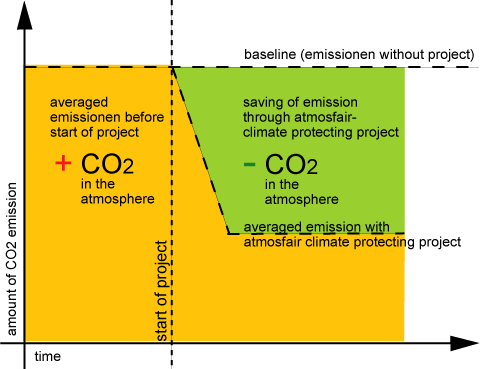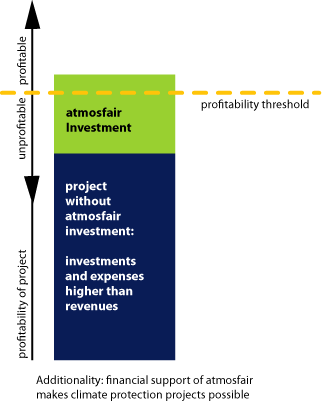atmosfair follows a uniform procedure for all offset projects. All projects can generally apply for funding. Ineligible projects are excluded on the basis of the criteria specified here (e.g. no HFC 23 projects, no afforestation, etc.). (Download exclusionary criteria).
The remaining projects are subject to an internal assessment by atmosfair to determine eligibility for funding. We check whether a project can be registered and carried in accordance with the CDM and Gold Standard and whether they conform to our own standards for high-quality offsetting. Information on CDM and Gold Standard can be found on this page, more information about project selection and process can be found here.
Project standards
A Comparison of standards for climate mitigation projects can be found here.
atmosfair climate change mitigation projects are either already registered as CDM Gold Standard projects or currently applying for registration. atmosfair certifies only micro-projects according to the Gold Standard Microscale.
CDM and Gold Standard
The CDM criteria were agreed upon at the international climate conference in Kyoto. CDM stands for “clean development mechanism.” It enables industrialized and developing countries to work together to implement climate protection projects in developing countries. All CDM-projects require verification in which an independent verifier examines and controls the project’s additionality and amount of savings. The verifier is liable for the report. In addition to sustainable emissions reduction, developing countries can also benefit from the influx of technology.
The following issues are important for the planning and validation of CDM climate protection projects:
1.) Quantification of the saved emissions: An exact comparison of the emissions generated by project with the “baseline” (i.e. the emissions that would have been created, had the project not occurred).

2.) The additionality criterion: A project is “additional” when it wouldn’t have taken place without the funding of atmosfair. It is a fundamental premise for the mitigation of global warming.

The reduction of emissions can be achieved in different ways: Working within the constraints of the Gold Standard requires that a project implements renewable energy or energy efficiency or that carbon is sequestered through means such as aforestation. On the other hand, a CDM project merely requires that dangerous greenhouse gases are converted to less dangerous ones.
The duration of a CDM project is ten years or (3 * 7) 21 years; for the latter, one new comprehensive analysis must be completed every seven years.
A project can only be registered once an independent verifier has thoroughly analyzed it, a hearing of the local population has taken place, the national authority gives its approval, and the UNFCCC (the climate protection ministry of the UN) decides to pass it. If a project is authorized, construction and operation can begin right away. At this stage, independent auditors regularly examine a specific project to verify that it is actually saving emissions. The UN awards saving certificates (CER = Certified Emission Reduction) for the amount of emissions prevented through a project. atmosfair archives these certificates in their official account at the Federal Environmental Agency. Additionally, atmosfair does not support unofficial offset projects that produce “VERs.”
The Gold Standard was developed by several environmental organizations under the special guidance of the WWF to ensure that CDM projects actually contribute to sustainable development. The following requirements must be demonstrably met:
- Gold Standard projects must either work exclusively with renewable energies, energy efficiency or composting
- Examination of the project with the help of a “sustainability matrix” (local employment, improved local environment, transfer of clean technology, etc.)
- Project planning with local communities and institutions
- Particularly strict proof of additionality must be given.
atmosfair climate protection projects are either already registered as CDM Gold Standard projects, or such registration is pending. atmosfair certifies only micro-projects according to the Gold Standard Microscale.
The project standards are described below. Please click here for further information on project selection and implementation.
Gold Standard microscale projects
The CDM is primarily designed as a mechanism for large-scale industrial projects. Since the expense for the examination procedure is largely independent of project size, the expense for small projects – which are often particularly innovative – may be disproportionately high. This causes a conflict of priorities for atmosfair: on the one hand, projects are to be examined according to the strict CDM guidelines; on the other, it is difficult to justify paying a major part of the project subsidy for the expenses of the examiner. In order for atmosfair to be able to continue to support small projects, the Atmosfair Integrity Council decided in 2010, to authorize small-scale projects in future under the Gold Standard VER Microscale as well. This is applicable for projects with CO2 savings of up to 10,000 t per year. The costs of examination here amount to approx. 5% of total costs, while they would be 5 to 10 times higher for CDM projects of these orders of magnitude. The examination contains all the criteria of the CDM examination, but is greatly simplified by comparison the latter, and is carried out by Gold Standard itself.
Adversary uses the Gold Standard Microscale mechanism to involve new technologies in countries where the preconditions for major projects are not yet present.
Further project categories
Moreover, atmosfair also supports pilot projects to test new innovative approaches for CO₂ reduction. These very small projects yield real CO₂ savings, which atmosfair does not, however credit to itself.
In atmosfair project in Germany, environmental education in schools is primary. Single projects lead to minimal direct CO₂ savings; these too are not credited to atmosfair. Much more important – albeit not statistically measurable – are the effects of enhanced climate awareness.


 Share
Share Tweet
Tweet